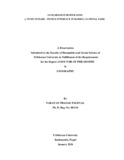Please use this identifier to cite or link to this item:
http://archive.nnl.gov.np:8080/handle/123456789/152| Title: | LIVELIHOOD IN BUFFER ZONE: A STUDY OF PARK – PEOPLE INTERFACE IN BARDIYA NATIONAL PARK |
| Authors: | PAUDYAL, NARAYAN PRASAD |
| Keywords: | National Park |
| Issue Date: | 22-Mar-2019 |
| Abstract: | Human-nature close relationship caused to develop the concept of conservation. Accordingly, the first National Park was established in America in 1872 which encouraged other countries in the world to establish such conservation areas. After long time, according to the concept of park-people friendly environment, the periphery area of the park was declared as Buffer Zone minimizing the destruction caused by wildlife on human, shelter and crops. In Nepal, it was implemented in 1996 and in the same year it was provisioned in Bardiya National Park (BNP). Gola and Shivapur, the two VDCs of BNP Buffer Zone (BZ) are benefited with the joint venture of park and people to mitigate crop damage, domestic animal depredation and human causality caused by wildlife. For the very purpose, park and local people have constructed barbed fence, machan and trench, and for public awareness, several programmes with income generation have been launched. However, due to improper management and inactiveness of concerned authority, wildlife are not in control and on the other hand, victims have not got proper compensation. The process is very complex and the amount is not sufficient. The study in Buffer Zone area of BNP, Nepal aims to examine the park-people interface in general and particularly, it tries to analyze the livelihood assets possessed and strategies adopted by Buffer Zone people of different caste/ethnicity. It also analyses the park-people interaction and their impacts on livelihood and management of Conservation Areas. Furthermore, it has attempted to observe the existing policy provisions for Buffer Zone management. Both qualitative and quantitative methods and techniques were applied to fulfill the research objectives. Participant Rural Appraisal, Focus Group Discussion, household survey using structural questionnaires, in-depth interview, key-informant interview, observation are the methods employed to generate primary data. Altogether, 210 households from Gola and Shivapur, the two VDCs of Buffer Zone were selected randomly for interview. |
| URI: | http://103.69.125.248:8080/xmlui/handle/123456789/152 |
| Appears in Collections: | 300 Social sciences |
Files in This Item:
| File | Description | Size | Format | |
|---|---|---|---|---|
| Final Dissertation.pdf | 6.25 MB | Adobe PDF |  View/Open |
Items in DSpace are protected by copyright, with all rights reserved, unless otherwise indicated.